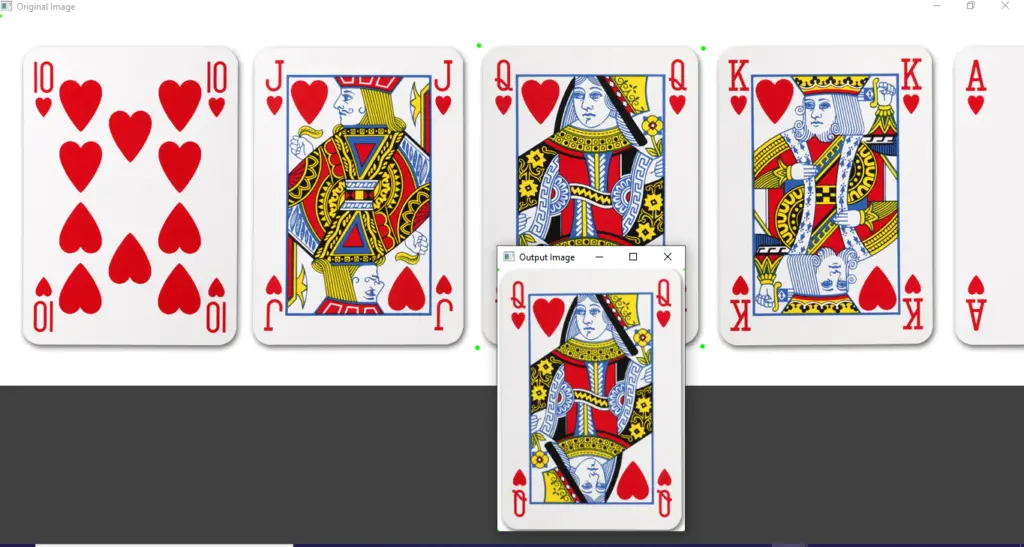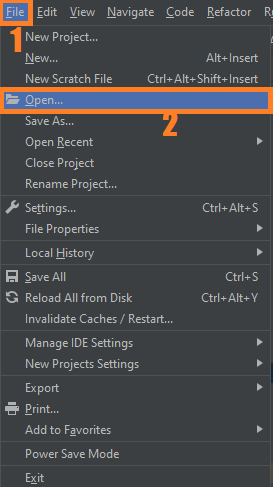Warp Perspective OpenCV Python With Source Code
This Python Project With Source Code will show you how to apply warping transformations to obtain a “birds-eye-view” of given cards image. From there, we will be able to crop out the selected card.
What is OpenCV?
OpenCV is short for Open Source Computer Vision. Intuitively by the name, it is an open-source Computer Vision and Machine Learning library.
This library is capable of processing real-time image and video while also boasting analytical capabilities. It supports the Deep Learning frameworks.
In this Python OpenCV Project also includes a downloadable Python Project With Source Code for free, just find the downloadable source code below and click to start downloading.
By the way if you are new to python programming and you don’t know what would be the the Python IDE to use, I have here a list of Best Python IDE for Windows, Linux, Mac OS that will suit for you.
I also have here How to Download and Install Latest Version of Python on Windows.
To start executing Warp Perspective OpenCV Python With Source Code, make sure that you have installed Python 3.9 and PyCharm in your computer.
Warp Perspective OpenCV Python With Source Code: Steps on how to run the project
Time needed: 5 minutes
These are the steps on how to run Warp Perspective OpenCV Python With Source Code
- Step 1: Download the given source code below.
First, download the given source code below and unzip the source code.

- Step 2: Import the project to your PyCharm IDE.
Next, import the source code you’ve download to your PyCharm IDE.

- Step 3: Run the project.
last, run the project with the command “py main.py”

Installed Libraries
import cv2 import numpy as np
Complete Source Code
################### Simple Detect #############
# import cv2
# def mousePoints(event,x,y,flags,params):
# if event == cv2.EVENT_LBUTTONDOWN:
# print(x,y)
#
# img = cv2.imread('Resources/cards.jpg')
# cv2.imshow("Original Image ", img)
# cv2.setMouseCallback("Original Image ", mousePoints)
# cv2.waitKey(0)
######### WARP PRESPECTIVE IMPLEMANTAION WITH MOUSE CLICKS ##################
import cv2
import numpy as np
circles = np.zeros((4,2),np.int)
counter = 0
def mousePoints(event,x,y,flags,params):
global counter
if event == cv2.EVENT_LBUTTONDOWN:
circles[counter] = x,y
counter = counter + 1
print(circles)
img = cv2.imread('card.jpg')
while True:
if counter == 4:
width, height = 250,350
pts1 = np.float32([circles[0],circles[1],circles[2],circles[3]])
pts2 = np.float32([[0,0],[width,0],[0,height],[width,height]])
matrix = cv2.getPerspectiveTransform(pts1,pts2)
imgOutput = cv2.warpPerspective(img,matrix,(width,height))
cv2.imshow("Output Image ", imgOutput)
for x in range (0,4):
cv2.circle(img,(circles[x][0],circles[x][1]),3,(0,255,0),cv2.FILLED)
cv2.imshow("Original Image ", img)
cv2.setMouseCallback("Original Image ", mousePoints)
cv2.waitKey(1)Output:

Download Source Code below
Anyway, if you want to level up your programming knowledge, especially Python OpenCV, try this new article I’ve made for you Best OpenCV Projects With Source Code For Beginners.
Summary
In this Python Project With Source Code we applied perspective and warping transformations using Python and OpenCV.
We utilized the cv2.getPerspectiveTransform and cv2.warpPerspective functions to accomplish these transformations.
We then reviewed a perspective transform OpenCV example.
Related Articles
- Code For Game in Python: Python Game Projects With Source Code
- Best Python Projects With Source Code FREE DOWNLOAD
- How to Make a Point of Sale In Python With Source Code
- Python Code For Food Ordering System | FREE DOWNLOAD
- Inventory Management System Project in Python With Source Code
Inquiries
If you have any questions or suggestions about Warp Perspective OpenCV Python With Source Code, please feel free to leave a comment below.




